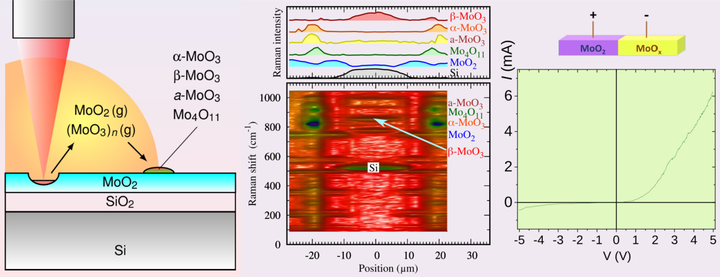Spatially resolved MoO$_x$ phases by laser localized oxidation of MoO$_2$: A possible route for all-molybdenum-oxide devices

Abstract
MoO$_2$ thin films were subjected to a laser localized oxidation process that allowed to obtain different well defined MoO$_x$ phases. In particular, spatially resolved MoO$_2$, $\alpha$-MoO$_3$, $\beta$-MoO$_3$, amorphous a-MoO$_3$, and Mo$4$O${11}$ regions were obtained as a function of the laser power and the distance to the laser focus. The origin of this spatial phase separation was investigated through a careful and exhaustive Raman mapping study covering several micrometres away from the laser focus and taking into account the thermochemical properties of the species involved. It was found that a sublimation/deposition process, driven by the different vapour pressures of the species, was responsible for the phase separation. At higher laser power, a solid state reaction was observed to contribute as well. In the laser annealed tracks, distant lateral sidebands of oxide deposition were observed with composition that depended on the laser power and the distance to the centre of the track. Electrical measurements between irradiated and non-irradiated regions showed a strong rectifying behaviour, revealing a transformation from metal-like to semiconducting Mo oxide phases, which may open the way to the development of laser written all-oxide electronic circuits.
Full citation:
O. de Melo, F. Agulló-Rueda and V. Torres-Costa,
“Spatially resolved MoO$_x$ phases by laser localized oxidation of MoO$_2$: A possible route for all-molybdenum-oxide devices,”
J. Mater. Chem. C 9, 6579–6588 (2021).
DOI: 10.1039/D1TC00696G